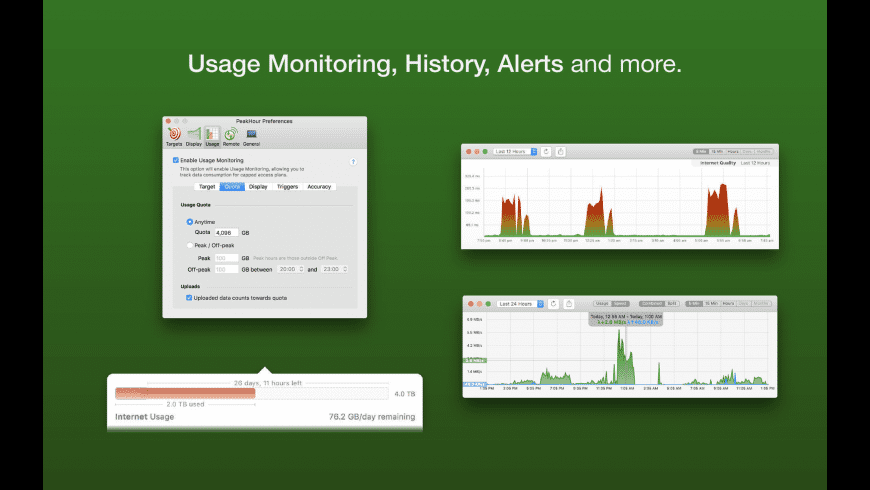PeakHour 3.1.5 Cracked Serial For Mac OS X Free Download. In: Mac Apps Cracked. PeakHour is a beautiful, real-time network-traffic visualizer that lives in your menu bar. It provides an instant view of your Internet or WiFi activity in real-time. PeakHour is great for monitoring your Internet or WiFi connection, and can help you.
- Peakhour mac版是一款Mac os平台上的一款帮助用户监控网络流量的Mac网络监控软件,为广大用户提供实时互联网或无线网络的活动即时视图;本站提供peakhour mac版下载已经激活,下载安装即可使用,需要可以下载试试。.
- PeakHour 3.1.5 Cracked Serial For Mac OS X Free Download. In: Mac Apps Cracked. PeakHour is a beautiful, real-time network-traffic visualizer that lives.
I’ve detailed my very favorite apps here in 2014 and Dan and I praised more apps last year. I’m not going to restate the stuff mentioned in those stories—yep, still writing this in BBEdit—but here are a few Mac apps that I’ve come to appreciate this past year.

PeakHour 3
Recently Comcast informed me that my home Internet data would be capped at 1TB per month. And it turns out that my family uses about 1.1TB per month on average. So I’m trying to figure out how we’re using that data, but it’s very hard to get a good idea of where the data is going, and when.
I discovered the $6 PeakHour 3, which talks to my SNMP-enabled home router to display charts of our data usage. To get the best idea of usage, I need to leave it running all the time, but since I have a Mac Mini that’s running all the time, that fits the bill. I’m even able to tell PeakHour my data cap and it can give me a sense of how ahead (or behind) we are month to month.
So far, what I’ve learned is that my kids are indeed the voracious Netflix and YouTube streamers that I knew them to be. I may end up paying an extra $50/month for unlimited data, but at least I’ll be well equipped with information about how we’re using our broadband before I get to that point.
iStat Menus
I used to pooh-pooh the idea of keeping little whizzy graphs in my Mac’s menu bar, but in the past year I’ve found value in the $18 iStat Menus 5. As a podcaster I’m trying to control the amount of data I’m using when I’m recording audio or video with other people, and iStat’s network module lets me see how much data my Mac is transferring at any given time. I also monitor the speed of my storage and how much processing power my iMac is using, largely to keep an eye out for unexpected slowdowns, which usually come courtesy of some helpful background process that’s trying to do something utterly unimportant to my task at hand.
iStat Menus is utterly configurable, so you can make it as whizzy or non-whizzy as you like. If you want to know at a glance what your Mac is up to, it’ll take care of you.
Calibre
I don’t love the Calibre ebook software—it’s exactly as clunky as you’d expect an open-source cross-platform software project to be—but it’s free and it works, and that counts for an awful lot. I use Calibre to convert ebooks to various formats. Ever since I bought the Kobo Aura One ebook reader, I’ve used Calibre to convert some of my Kindle books to read on the Aura One’s larger screen. And I use Calibre frequently to convert ePubs into a Kindle-compatible format.
iZotope RX 5
Podcasting’s funny. Some people build themselves a home studio and buy an expensive microphone while other people keep it low cost and can’t escape the hum of a heater or the whine of their laptop fans. Noises like that don’t make for good podcast audio, so the first thing I do before editing a podcast is strip the noise out of the audio files. And for about a year now, I’ve been using the $349 iZotope RX 5 to do the job. No, it’s not cheap—though as I write this it’s on sale for $262—but it’s a pretty amazing collection of tools. The broadband-noise-removal tool is one of my go-to items, but it’s got a de-reverb filter that will take the echo out of noisy rooms and a de-hum filter that will banish even the most persistent buzz from a furnace.
And then there’s the editor app itself, which displays sound not just as waveforms, but with a spectrum view that makes it easy to see areas of noise—saving a whole lot of time.
Could I edit podcasts without iZotope RX 5? Sure I could. But they wouldn’t sound as good—or perhaps more accurately, some of my guests would sound distinctly inferior to others, and that’s not very nice.
Transmit
Sometimes it feels like I move files around for a living. I’m constantly uploading podcasts and image files for redistribution to the big wide world, and that requires a tool to get those files from point A (my Mac) to point B (some server out there in the world). Panic’s $34 Transmit is my tool of choice for these tasks. I’ve got favorites set up for all of my usual destinations, so with a double-click I’ve got access to all my files. If I need to edit a file on my server, I can double-click and it’ll open automatically in my text editor of choice—and when I make changes and type Command-S, Transmit immediately saves it back up to the server. I’ve even built Automator actions to auto-upload images to Six Colors once they’ve been resized and saved in the proper format.
Keyboard Maestro
I had resisted Keyboard Maestro for years. If I couldn’t script something I needed to automate, it couldn’t be done, I thought. But then I realized I had a complex workflow that I was executing every single time I recorded a podcast, and no amount of scripting would be able to model all the mouse clicks that were required as a part of the workflow. So I turned at last to Stairways Software’s Keyboard Maestro, which I’ve used not only to simplify my podcast workflow setup, but to remap keys on my weird clicky keyboard so that they work with the way I use my Mac. I can’t really find anything Keyboard Maestro can’t do. And it’s a lot easier to build something in Keyboard Maestro than it is to write a script—which is a big deal if you’re a person who wouldn’t mind automating a bunch of repetitive tasks on your Mac, but is never going to learn a scripting language.
Loopback
The Mac’s audio routing capabilities should probably be better. There’s no native way to create virtual inputs and outputs and route sound from one app to another. What’s worse, the release of Lion broke almost every sound utility on the platform that was dedicated to working around those limitations.
This year we got a big piece of the puzzle back with the easy to use and reliable Loopback. Combined with Rogue Amoeba’s Audio Hijack, this solves pretty much all of my audio routing problems. With Loopback, you can create virtual inputs and outputs so that you can send different inputs to different places, merge and combine inputs, pretty much anything you want. Is it a utility that appeals to a limited audience? Absolutely. But I’m in the audience, and I love Loopback.
If you appreciate articles like this one, support us by becoming a Six Colors subscriber. Subscribers get access to an exclusive podcast, members-only stories, and a special community.

Want to monitor your Mac(s) with PeakHour?
PeakHour Enabler is a small, additional tool that makes it easy to allow your Mac(s) to be monitored directly with PeakHour. It can automatically configure and start your Mac's snmpd (SNMP daemon) to enable it to listen to requests from SNMP clients such as PeakHour.
Get PeakHour Enabler

Get the latest version of PeakHour Enabler here:
Using PeakHour Enabler
To enable your Mac for monitoring with PeakHour:
- Download PeakHour Enabler by clicking the link above.
- Run PeakHour Enabler from your Downloads folder:
- Change any settings you'd like (see below for more information).
Note: we recommend you either disable the 'From other computers' option or change the community string / password to something other than public. - Click Update & Enable SNMP.
- When prompted, enter your local Mac account password.
- Configure PeakHour to monitor your Mac (see below for how to do this).
PeakHour Enabler Settings
There are essentially two settings that you can configure:
| Setting | Description |
|---|---|
| SNMP Community - From this computer | This is the SNMP community (or password) that will be required to talk to this Mac via SNMP from this computer. If PeakHour is running on this Mac, this is the SNMP community you need to enter when clicking the Add SNMP Device button in PeakHour. |
| SNMP Community - From other computers | This is the SNMP community (or password) that will be required to talk to this Mac via SNMP from other computers on your local network. If PeakHour is running on a different Mac on your network, this is the SNMP community you need to enter when clicking the Add SNMP Device button in PeakHour. Note you can disable SNMP access from other computers by unchecking the checkbox. |
Configuring PeakHour
Once you have enabled snmpd on your Mac using the steps above, you can now add your Mac as a Target to PeakHour.
Peak Hour 3 Mac Peak Hour 3 For Mac Os
Here's a quick illustration of how to do this:
Peak Hour 3 Mac Peak Hour 3 For Macbook Pro
- Click the + button in Preferences > Targets (if you're launching for the first time, you can skip this step as the Configuration Assistant will appear automatically).
If you specified public for the community name, click Scan for SNMP Devices checkbox to automatically find your Mac on the local network.
The line highlighted in red is the local machine, which we just set up with PeakHour Enabler.If you chose something other than public as the community string, or your Mac is on a different network, click the Add SNMP Device... button and enter the Hostname / IP address of your Mac along with the community name in the next screen.
If you disabled From other computers in PeakHour Enabler, you must enter 'localhost' as the Device Name.
- Next, choose an interface to monitor. Note that interface names in SNMP to do not resemble those in Network Preferences. If you're unsure which interface to choose (e.g. is en0 Ethernet or WiFi), double-check the IP address shown in PeakHour with the IP address in System Preferences.
- Step through the rest of the wizard and adjust any additional settings.
- You should now be able to see your Mac's network activity in PeakHour: